Resident Evil, or Biohazard in Japan and parts of Southeast Asia, is a Japanese horror game series and media franchise created by Capcom. It consists of survival horror, third-person shooter and first-person shooter games, with players typically surviving in environments inhabited by zombies and other frightening creatures. The franchise has expanded into other media, including a live-action film series, animated films, television series, comic books, novels, audio dramas and merchandise. Resident Evil is the highest-grossing horror franchise.

Resident Evil 2 is a 1998 survival horror video game developed and published by Capcom for the PlayStation. The player controls rookie cop Leon S. Kennedy and college student Claire Redfield, who must escape Raccoon City after its citizens are transformed into zombies by a biological weapon two months after the events of the original Resident Evil. The gameplay focuses on exploration, puzzles, and combat; the main difference from its predecessor are the branching paths, with each player character having unique storylines, partners and obstacles.
Jill Valentine is a character in Resident Evil, a survival horror video game series created by the Japanese company Capcom. She was introduced as one of the two player characters in the original Resident Evil (1996), alongside her partner Chris Redfield, as a member of the Raccoon City Police Department's Special Tactics And Rescue Service (S.T.A.R.S.) unit. Jill and Chris fight against the Umbrella Corporation, a pharmaceutical company whose bioterrorism creates zombies and other bio-organic weapons, and later become founding members of the United Nations' Bioterrorism Security Assessment Alliance (BSAA).
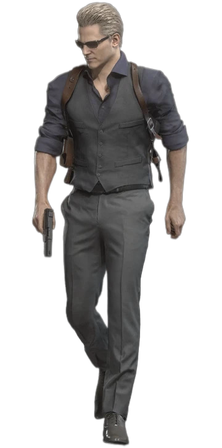
Albert Wesker is a character in Resident Evil, a survival horror video game series created by the Japanese company Capcom. He was first introduced in the original Resident Evil (1996) as the captain of the Raccoon Police Department's Special Tactics And Rescue Service (S.T.A.R.S.) unit. Wesker has been one of the series' main antagonists as a member of the Umbrella Corporation, manipulating story events behind-the-scenes. To further his own plans, Wesker betrays his allies, fakes his death, gains superhuman abilities, and works with both Umbrella's mysterious rival company and their successors in the field of biological weapons development until his ultimate defeat by Chris Redfield in Resident Evil 5 (2009).

Resident Evil 3 is a 2020 survival horror game developed and published by Capcom. It is a remake of the 1999 game Resident Evil 3: Nemesis. Players control former elite agent Jill Valentine and mercenary Carlos Oliveira as they attempt to find a vaccine and escape from a city during a viral outbreak. The game is played from a third-person perspective and requires the player to solve puzzles and defeat monsters while being pursued by a creature called Nemesis. It was released for PlayStation 4, Windows, and Xbox One in April 2020 and for Amazon Luna, PlayStation 5, and Xbox Series X/S in June 2022, with a Nintendo Switch cloud version also released in November 2022.

Resident Evil Zero is a survival horror video game developed and published by Capcom for the GameCube in 2002. It is a prequel to Resident Evil (1996), covering the ordeals experienced in the Arklay Mountains by special police force unit, the S.T.A.R.S. Bravo Team. The story takes place in July 1998 and follows officer Rebecca Chambers as well as convict Billy Coen as they explore an abandoned training facility for employees of the pharmaceutical company Umbrella. The gameplay is similar to other Resident Evil games, but adds the ability to switch between characters to solve puzzles and use unique abilities.
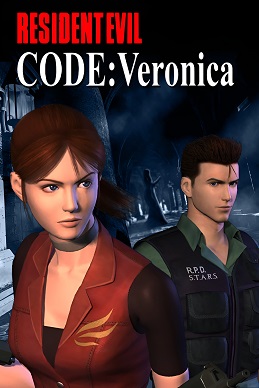
Resident Evil – Code: Veronica is a survival horror video game developed and published by Capcom and originally released for the Dreamcast in 2000. It is the fourth main installment in the Resident Evil series and the first to debut on a separate platform from the PlayStation. The story takes place three months after the events of Resident Evil 2 (1998) and the concurrent destruction of Raccoon City as seen in Resident Evil 3: Nemesis (1999). It follows Claire Redfield and her brother Chris Redfield in their efforts to survive a viral outbreak at a remote prison island in the Southern Ocean and a research facility in Antarctica. The game retains the traditional survival horror controls and gameplay of previous installments; however, unlike the pre-rendered backgrounds of previous games, Code: Veronica uses real-time 3D environments and dynamic camera movement.

Resident Evil Survivor is a light gun shooter video game developed by Tose and published by Capcom. It was released on the PlayStation in Japan on January 27, 2000, in Europe on March 31, 2000, and in North America on August 30, 2000. It is a spin-off of the Resident Evil video game series. It is also the first first-person perspective Resident Evil game predating Resident Evil 7: Biohazard by seventeen years. A Microsoft Windows version was released only in China and Taiwan on September 7, 2002.

Resident Evil Outbreak is a survival horror video game developed and published by Capcom for the PlayStation 2. It was released on December 11, 2003 in Japan, on March 30, 2004 in North America, and on September 17, 2004 in PAL regions. It was the first entry in the Resident Evil video game series to feature cooperative gameplay and online multiplayer support, although online support was not available for the PAL versions of the game.

Resident Evil: Extinction is a 2007 action horror film directed by Russell Mulcahy and written by Paul W. S. Anderson. A direct sequel to Resident Evil: Apocalypse (2004), it is the third installment in the Resident Evil film series, which is loosely based on the Capcom survival horror video game series of the same name. The film follows the heroine Alice, along with a group of survivors from Raccoon City, as they attempt to travel across the Mojave desert wilderness to Alaska and escape a zombie apocalypse.
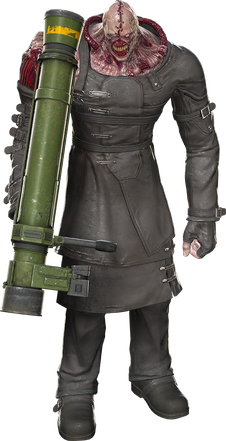
The Nemesis, also called the Nemesis-T Type, or the Pursuer, is a character in Resident Evil, a survival horror video game series created by the Japanese company Capcom. Although smaller than other Tyrant models, the creature dwarfs a typical human, and possesses vastly superior intelligence and physical dexterity to its undead peers. It is featured in Resident Evil 3: Nemesis (1999) as a titular main villain before later emerging in other titles and cameo roles. It is also featured on various merchandise and was portrayed by Matthew G. Taylor in the 2004 film Resident Evil: Apocalypse. The character is voiced by Tony Rosato in the original game and Gregg Berger in Operation Raccoon City (2012). In the 2020 remake of Resident Evil 3, the character is voiced by David Cockman, with Neil Newbon providing the motion capture performance. Nemesis has also been featured in several other game franchises, including as a playable character in Marvel vs. Capcom and Dead by Daylight.

Resident Evil: The Umbrella Chronicles is an on-rails light gun shooter video game developed by Capcom and Cavia as part of the Resident Evil series. The game was released for the Wii on November 13, 2007, in North America; November 15, 2007, in Japan; and on November 30, 2007, in Europe, excluding Germany, where the game is not available due to the refusal of a USK rating and its subsequent inclusion in the index. It was followed by Resident Evil: The Darkside Chronicles. Both Chronicles games are included on the Resident Evil Chronicles HD Collection for the PlayStation 3.

Resident Evil 6 is a 2012 third-person shooter video game developed and published by Capcom. A major installment in the Resident Evil series, Resident Evil 6 was released for the PlayStation 3 and Xbox 360 in October 2012, and for Windows in March 2013. It was re-released with all downloadable content for the PlayStation 4 and Xbox One in March 2016, and for the Nintendo Switch in October 2019. Players control Leon S. Kennedy, Chris Redfield, Jake Muller and Ada Wong as they confront the force behind a worldwide bio-terrorist attack. The story is centred around their four interwoven campaigns, and every campaign features a unique style in both tone and gameplay.
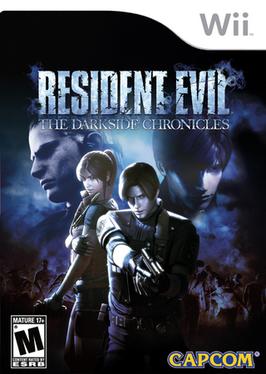
Resident Evil: The Darkside Chronicles is an on-rails light gun shooter video game for the Wii developed by Capcom and Cavia as part of the Resident Evil series. The game was released for the Wii on November 17, 2009, in North America. It serves as a prequel to Resident Evil 4, set 2 years before its events. It was released in Europe on November 27, 2009, bundled with the Wii Zapper accessory.
Resident Evil is an action horror film series based on the Japanese video game franchise by Capcom.

Resident Evil: Operation Raccoon City is a squad-based third-person shooter video game for Microsoft Windows, PlayStation 3 and Xbox 360, co-developed by Slant Six Games and Capcom. It was released on March 20, 2012 in North America, March 22, 2012 in Australia, March 23, 2012 in Europe and April 26, 2012 in Japan.

Resident Evil Survivor 2 – Code: Veronica is a light gun shooter video game developed and published by Capcom as part of the Resident Evil series. The arcade version was developed in conjunction with Namco for the arcade machines. The game was released for Sega NAOMI and PlayStation 2. It was released on the PlayStation 2 on November 8, 2001 in Japan and in Europe on March 22, 2002. Whilst the Playstation 2 release is a light gun shooter, the NAOMI arcade release features no lightgun technology whatsoever, instead deferring control of each player entirely to a three-axis joystick in the shape of a gun. The game is the second instalment in the Gun Survivor series and the sequel to Resident Evil Survivor. The game is adapted from Resident Evil – Code: Veronica and features enemies and characters from that game, and enemies from Resident Evil 2 and 3. It was followed by Dino Stalker which is a spin-off of Dino Crisis, and has no ties to Resident Evil.
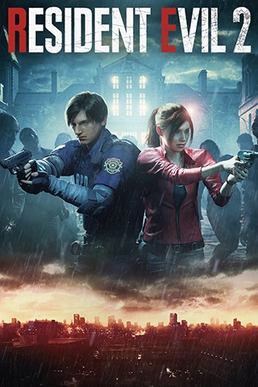
Resident Evil 2 is a 2019 survival horror game developed and published by Capcom. A remake of the 1998 game Resident Evil 2, it was released for PlayStation 4, Windows, and Xbox One in January 2019 and for Amazon Luna, PlayStation 5 and Xbox Series X/S in June 2022, and a Nintendo Switch cloud version released in November 2022. Players control the rookie police officer Leon S. Kennedy and the college student Claire Redfield as they attempt to escape Raccoon City during a zombie outbreak.

Resident Evil: Resistance is a 2020 survival horror game developed by NeoBards Entertainment and published by Capcom as the online component for Resident Evil 3. Released for PlayStation 4, Windows, and Xbox One, it involves four survivor players competing against a mastermind player who can create traps, enemies and other hazards. The game received mixed reviews from critics, who criticized the game for being unbalanced, having technical issues and for lacking dedicated servers.

















